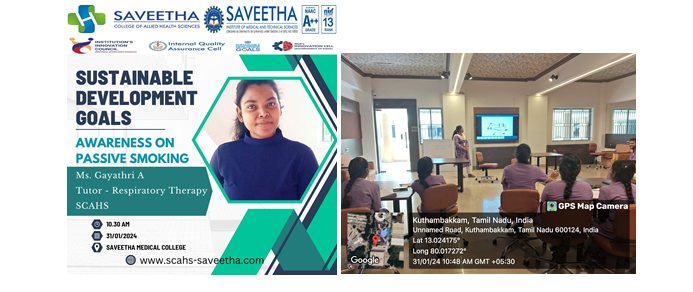
By – A.Gayathri – Tutor in the Department of Respiratory, Saveetha College of Allied Health Sciences, SIMATS, Chennai.
Passive smoking, also known as secondhand smoke, occurs when a person involuntarily inhales the smoke from others who are smoking nearby. It poses health risks similar to active smoking, contributing to respiratory and cardiovascular problems, especially in children and non-smoking adults. Reducing exposure to secondhand smoke is crucial for overall health.Hence we Saveetha College of Allied Health Sciences conducted an Awareness on passive smoking to Students.
Cigarette smoke contains over 7,000 chemicals, and more than 250 of them are known to be harmful, with at least 69 identified as carcinogens. These chemicals are released during the burning of tobacco and can have harmful effects on both smokers and those exposed to secondhand smoke. Common toxic substances in cigarette smoke include nicotine, tar, carbon monoxide, formaldehyde, benzene, and various heavy metals. Understanding these harmful components highlights the health risks associated with smoking and exposure to cigarette smoke.
Respiratory Issues: Increased risk of respiratory infections, asthma, and decreased lung function, especially in children.
Cardiovascular Problems: Higher chances of heart disease and stroke due to exposure to secondhand smoke.
Cancer Risk: Elevated risk of lung cancer, particularly in non-smoking adults exposed to long-term secondhand smoke.
Children’s Health: Greater vulnerability in infants and children, leading to sudden infant death syndrome (SIDS), respiratory infections, and developmental issues.
Pregnancy Complications: Increased risk of complications during pregnancy, such as low birth weight and pre-term birth.Exposure to passive smoking during pregnancy has been linked to an increased risk of fetal death, preterm birth, and low birth weight. The harmful substances in secondhand smoke can restrict fetal oxygen supply, affect placental function, and lead to complications. Pregnant individuals should avoid exposure to smoke to safeguard the health of both themselves and their unborn child.
Public awareness of the dangers of passive smoking has increased over the years. Efforts by health organizations, educational campaigns, and smoking bans in public spaces have contributed to raising awareness about the harmful effects of secondhand smoke. It is crucial for individuals to understand the risks associated with passive smoking, not only for their own health but also for the well-being of those around them, particularly vulnerable groups like children and pregnant women. Ongoing education and advocacy continue to play a key role in promoting a smoke-free environment.
In conclusion, passive smoking remains a significant public health concern, with documented risks for respiratory and cardiovascular issues. Implementing and promoting smoke-free
environments is imperative to safeguard the well-being of non-smokers, particularly vulnerable populations like children and non-smoking adults. Public awareness and policy measures are vital in addressing the adverse effects of passive smoking.
Saveetha College of Allied Health Sciences Conducted a session on ‘AWARNESS ON PASSIVE SMOKING’- SDG (Sustainable Development Goals) in Saveetha Medical College
Leave a Reply